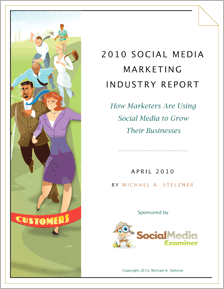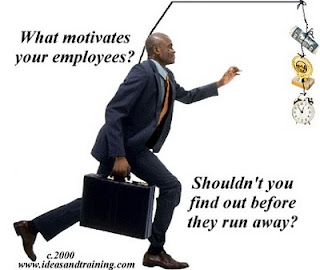 A Social Media Marketing report highlights the trends of 2010, and is based on survey responses elicited from 1898 respondents who covered the entire spectrum – from unemployed people to those who own their own business. Respondents were people who worked at large corporations, or those who were in B2Bs, as well as those who were trying to close leads with customers.
A Social Media Marketing report highlights the trends of 2010, and is based on survey responses elicited from 1898 respondents who covered the entire spectrum – from unemployed people to those who own their own business. Respondents were people who worked at large corporations, or those who were in B2Bs, as well as those who were trying to close leads with customers.Almost 57% of survey participants were focused primarily on attracting businesses (B2B)and 43% primarily targeted consumers(B2C). Most survey participants (75.1%) were between the ages of 30 and 59 and 60% were female.
The hot area getting a lot of talk-time is mobile marketing but this report says that, currently, only the bigger businesses (60%) are primarily looking to leverage mobile apps. The biggest percentage (73%) were seeking to optimize their websites for mobile browsing. Around 59% wanted to use mobile apps to network with fans, 57% wanted to create custom apps and 52% were interested in mobile advertising. B2C companies were much more interested in interacting with mobile fans (65.4% of B2C versus 54.6% of B2B).
All in all, 75% of businesses claimed to be using mobile apps to interact with ‘fans’ but paradoxically, with only 18% saying they were interested in advertising to them.
On whether, firms were outsourcing their social marketing efforts – a huge 86% were not doing it. But among those who were, 25.7% of large businesses and 25% of mid-sized businesses are currently outsourcing, compared to only 10.6% of sole proprietors.
All of these business owners reported benefits like marketing costs had dropped significantly, especially for sole proprietors, 85% said more business was generated and 56% said it helped develop new partnerships.
Search engine rankings increased for 73% of the businesses polled – with more B2Bs connecting than B2C engagement. The majority of marketers (56%) are using social media for 6 hours or more each week, and nearly one in three invest 11 or more hours weekly.
Here is what marketing personnel in most firms were looking at mastering on social networks.
 -Tools marketers want to learn more about for those just getting started - For those just getting underway, understanding Twitter tops the list, followed by Facebook, blogs and LinkedIn. Though, in 2009, Facebook was in fourth place at 77% and blogs were in second place at 79%. This year, the order has reversed with Facebook at 87% and blogs at 70%.
-Tools marketers want to learn more about for those just getting started - For those just getting underway, understanding Twitter tops the list, followed by Facebook, blogs and LinkedIn. Though, in 2009, Facebook was in fourth place at 77% and blogs were in second place at 79%. This year, the order has reversed with Facebook at 87% and blogs at 70%.-Tools marketers want to learn more about for those who've been using social media for a few months - Social bookmarking sites top the interest list for these professionals. Mastering Twitter also remains important for marketers who've been doing social media marketing for a few months.
-Tools marketers want to learn more about for those who've been using social media for years - These pros are most interested in understanding Twitter and Ning sites.
-Social bookmarking sites edged out Twitter – with 61% of people saying they wanted to know more about sites like Del.icio.us, which ironically despite a 5 million user base is going to be shut down by Yahoo, which acquired it in 2005, and then failed to properly optimize it.
-The report also states, small businesses owners were more interested in understanding social bookmarking sites than other groups. In addition, those over age 50 were much more interested in learning about Twitter than their younger marketing cohorts.
-Males were most interested in learning how to use Facebook and females were most interested in learning about social bookmarking.
-B2C most want to learn about Twitter. B2B are most interested in social bookmarking.
What’s really telling is that sites like Ning, Digg, Reddit, StumbleUpon, MySpace have got reams of publicity but this survey shows that a huge 72% have no wish to utilize it. Only 11.1% of B2C businesses are planning on increasing their MySpace activities. Similarly, with Ning – a platform that allows people to create their very own social media network (as if we needed anymore of them!) – only 21% of the existing users plan to increase their involvement but 57% will not utilize it at all. Meanwhile, social news sites like Digg etc will 36% looking to increase usage as opposed to 38% who don’t want to use it at all. Around 39% of B2B plan on increasing their social news site use versus just
32.9% of B2C.
 LinkedIn emerges as a clear frontrunner - with 67% planning increased use of this service and just 8% saying they won’t be using it at all. B2B are significantly more likely to plan on increasing their use of LinkedIn (72.1% of B2B versus 59.1% of B2C). There is more B2B participation here at 83%.Other winners are Facebook, YouTube and Twitter.
LinkedIn emerges as a clear frontrunner - with 67% planning increased use of this service and just 8% saying they won’t be using it at all. B2B are significantly more likely to plan on increasing their use of LinkedIn (72.1% of B2B versus 59.1% of B2C). There is more B2B participation here at 83%.Other winners are Facebook, YouTube and Twitter.-Facebook – 76% said they would increase usage – out of which 80.1% of B2C plan on increasing their efforts. 85.4% of large businesses will also increase their Facebook activities. More B2C participation here at 92%. Those just starting to use social networks, want to begin with Facebook, followed by Twitter and LinkedIn.
-YouTube/Video - A significant 73% of marketers plan on increasing their YouTube and/or video marketing. B2C are more likely to employ video (75.6%) than B2B (70.8%). Those who've been using social media for years picked this as the top area in which they will be increasing their efforts, with 81% responding affirmatively. Marketers with less time to spare but who have been long-time users of social media, use YouTube (or other video services) more. Also 51.2% of all men compared to only 42.6% of women use videos.
-Twitter - 93% of marketers are using Twitter and 71% plan on increasing their use of the network to further their marketing objectives. 85% of large businesses will be increasing their Twitter activities. This medium is being used by 96% of long term users followed by Facebook.
-Blogs - 81% said blogging activity will be increased, 5% said they won’t do anything and only 1% said they will decrease this activity.
 Overall, at least 67% of marketers plan on increasing their use of blogs, Facebook, YouTube, Twitter and LinkedIn. Beginners were there for 1 hour a week on an average, as compared to their more experienced counterparts, who are online for 10 hours a week. Also sole ownership enterprises used social media a lot more than big businesses and also saw substantial improvement in lead generation and creating a buzz.
Overall, at least 67% of marketers plan on increasing their use of blogs, Facebook, YouTube, Twitter and LinkedIn. Beginners were there for 1 hour a week on an average, as compared to their more experienced counterparts, who are online for 10 hours a week. Also sole ownership enterprises used social media a lot more than big businesses and also saw substantial improvement in lead generation and creating a buzz.These numbers are really interesting to note because it really shows that a huge chunk of people are just not that engaged with all these 'lesser' sites, that have cropped up and crowded mind-space so much. People would rather have fewer choices. Fewer and credible sites, that will be around, like the e-mail services each of us uses today, and which is the most vital social link connecting everyone, that was ever created.
The rest, with the exception of LinkedIn and Twitter, are looking to create utility value for their services, by adding frills and thrills. How long people choose to be dazzled, with even more flashy apps and tweaks built into some of these social mediums, is anyone's guess.
PS – If you want Qs like these answered: # How do I measure social media return on investment? # What are the social media marketing best practices? # How do I best manage my time with social media? # How do I reach my target markets with social media? # How do I generate traffic and leads using social media? and more - then download this great looking report for more details here - http://marketingwhitepapers.s3.amazonaws.com/SocialMediaMarketingReport2010.pdf




